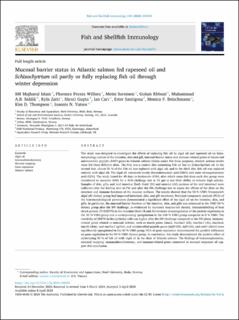| dc.contributor.author | Islam, SM Majharul | |
| dc.contributor.author | Willora, Florence Perera | |
| dc.contributor.author | Sørensen, Mette | |
| dc.contributor.author | Rbbani, Golam | |
| dc.contributor.author | Siddik, Muhammad A.B. | |
| dc.contributor.author | Zatti, Kyla | |
| dc.contributor.author | Gupta, Shruti | |
| dc.contributor.author | Carr, Ian | |
| dc.contributor.author | Santigosa, Ester | |
| dc.contributor.author | Brinchmann, Monica F. | |
| dc.contributor.author | Thompson, Kim D. | |
| dc.contributor.author | Vatsos, Ioannis N. | |
| dc.date.accessioned | 2024-04-15T09:03:08Z | |
| dc.date.available | 2024-04-15T09:03:08Z | |
| dc.date.created | 2024-04-08T18:15:43Z | |
| dc.date.issued | 2024 | |
| dc.identifier.citation | Islam, S. M. M., Willora, F. P., Sørensen, M., Rbbani, G., Siddik, M. A. B., Zatti, K., Gupta, S., Carr, I., Santigosa, E., Brinchmann, M. F., Thompson, K. D. & Vatsos, I. N. (2024). Mucosal barrier status in Atlantic salmon fed rapeseed oil and Schizochytrium oil partly or fully replacing fish oil through winter depression. Fish and Shellfish Immunology, 149: 109549. doi: | en_US |
| dc.identifier.issn | 1095-9947 | |
| dc.identifier.uri | https://hdl.handle.net/11250/3126474 | |
| dc.description.abstract | The study was designed to investigate the effects of replacing fish oil by algal oil and rapeseed oil on histomorphology indices of the intestine, skin and gill, mucosal barrier status and immune-related genes of mucin and antimicrobial peptide (AMP) genes in Atlantic salmon (Salmo salar). For these purposes, Atlantic salmon smolts were fed three different diets. The first was a control diet containing fish oil but no Schizochytrium oil. In the second diet, almost 50% of the fish oil was replaced with algal oil, and in the third diet, fish oil was replaced entirely with algal oil. The algal oil contained mostly docosahexaenoic acid (DHA) and some eicosapentaenoic acid (EPA). The study lasted for 49 days in freshwater (FW), after which some fish from each diet group were transferred to seawater (SW) for a 48-hour challenge test at 33 ppt to test their ability to tolerate high salinity. Samples of skin, gills, and mid intestine [both distal (DI) and anterior (AI) portions of the mid intestine] were collected after the feeding trial in FW and after the SW-challenge test to assess the effects of the diets on the structure and immune functions of the mucosal surfaces. The results showed that the 50% VMO (Veramaris® algal oil) dietary group had improved intestinal, skin, and gill structures. Principal component analysis (PCA) of the histomorphological parameters demonstrated a significant effect of the algal oil on the intestine, skin, and gills. In particular, the mucosal barrier function of the intestine, skin, and gills was enhanced in the VMO 50% dietary group after the SW challenge, as evidenced by increased mucous cell density. Immunolabelling of heat shock protein 70 (HSP70) in the intestine (both DI and AI) revealed downregulation of the protein expression in the 50% VMO group and a corresponding upregulation in the 100% VMO group compared to 0% VMO. The reactivity of HSP70 in the epithelial cells was higher after the SW challenge compared to the FW phase. Immune-related genes related to mucosal defense, such as mucin genes [muc2, muc5ac1 (DI), muc5ac1 (AI), muc5ac2, muc5b (skin), and muc5ac1 (gills)], and antimicrobial peptide genes [def3 (DI), def3 (AI), and cath1 (skin)] were significantly upregulated in the 50% VMO group. PCA of gene expression demonstrated the positive influences on gene regulation in the 50% VMO dietary group. In conclusion, this study demonstrated the positive effect of substituting 50% of fish oil with algal oil in the diets of Atlantic salmon. The findings of histomorphometry, mucosal mapping, immunohistochemistry, and immune-related genes connected to mucosal responses all support this conclusion. | en_US |
| dc.language.iso | eng | en_US |
| dc.publisher | Elsevier | en_US |
| dc.rights | Navngivelse 4.0 Internasjonal | * |
| dc.rights.uri | http://creativecommons.org/licenses/by/4.0/deed.no | * |
| dc.title | Mucosal barrier status in Atlantic salmon fed rapeseed oil and Schizochytrium oil partly or fully replacing fish oil through winter depression | en_US |
| dc.type | Peer reviewed | en_US |
| dc.type | Journal article | en_US |
| dc.description.version | publishedVersion | en_US |
| dc.rights.holder | © 2024 The Author(s) | en_US |
| dc.source.pagenumber | 19 | en_US |
| dc.source.volume | 149 | en_US |
| dc.source.journal | Fish and Shellfish Immunology | en_US |
| dc.identifier.doi | 10.1016/j.fsi.2024.109549 | |
| dc.identifier.cristin | 2260000 | |
| dc.relation.project | NordForsk: 104310 | en_US |
| dc.relation.project | The Research Council of Norway: 327109 | en_US |
| dc.source.articlenumber | 109549 | en_US |

